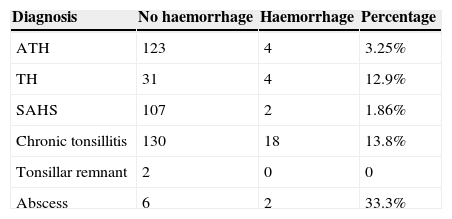Tonsillectomy represents one of the main surgical procedures for the otolaryngologist, with haemorrhage being the most common postoperative. The objective of this study was to determine the post-tonsillectomy haemorrhage rate, and relate the surgical technique, diagnosis and patient age.
MethodsThis was a retrospective study, from April 2012 to January 2014, covering 429 patients. We used the following surgical-dissection techniques: cold, Colorado needle and monopolar forceps. Haemostasis was carried out in every case with monopolar forceps and gauze compression.
ResultsPost-tonsillectomy haemorrhage rate was 6.99%. According to the surgical technique used, with Colorado needle dissection, the bleeding rate we found was 7.07%; with monopolar forceps dissection, the rate was 20.4%; and with cold dissection, 2.9%. Of all haemorrhages, only 9 (2.09%) needed reintervention, of which 40% were performed with monopolar forceps dissection. The group with the largest bleeding rate was that of more than 14 years old. The diagnosis most associated with bleeding was peritonsillar abscess.
ConclusionThe lowest bleeding rate was found with cold dissection and monopolar forceps haemostasis (2.09%). Consequently, based on our experience and the results obtained in the study, we consider that surgical technique does influence post-tonsillectomy haemorrhage.
La amigdalectomía representa uno de los principales procedimientos quirúrgicos del otorrinolaringólogo, siendo la hemorragia la complicación posquirúrgica más frecuente. El objetivo de este estudio es determinar la tasa de hemorragia postamigdalectomía y relacionarlo con la técnica quirúrgica, el diagnóstico y la edad del paciente.
MétodosSe realiza un estudio retrospectivo con un período comprendido desde abril de 2012 a enero de 2014 con un total de 429 casos. Se emplearon las siguientes técnicas quirúrgicas de disección: fría, punta de colorado y pinza monopolar. La hemostasia se realizó en todos los casos con pinza monopolar y compresión con gasa.
ResultadosLa tasa de hemorragia postamigdalectomía fue del 6,99%. Según la técnica empleada, con la disección con punta de colorado obtuvimos una tasa de sangrado del 7,07%, con disección con pinza monopolar del 20,4% y con disección fría del 2,9%. De todas las hemorragias, únicamente 9 (2,09%) necesitaron revisión quirúrgica, de las cuales el 40% habían sido realizadas con la técnica de pinza monopolar. El grupo con mayor tasa de sangrado fue el de más de 14 años; y el diagnóstico que más se relacionó con hemorragias fue el de absceso periamigdalino.
ConclusionesLa técnica con menor tasa de sangrado es la disección fría con hemostasia con pinza monopolar (2,9%). Por lo tanto, según nuestra experiencia y los datos obtenidos con este estudio, consideramos que la técnica quirúrgica sí influye en la aparición de hemorragias.









